143 years ago, a devastating fire overtook much of the Thumb over several days. Here is an overview of the days of that horrific event and its aftermath.
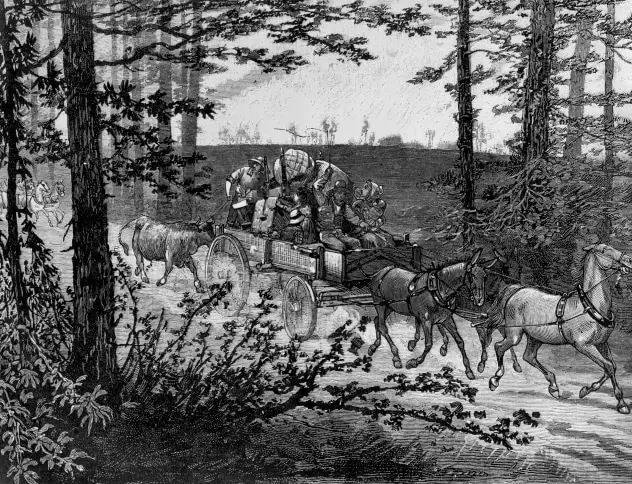
Table of Contents
Years of Lumbering Debris and Drought Created Fuel for 1881 Michigan Fire
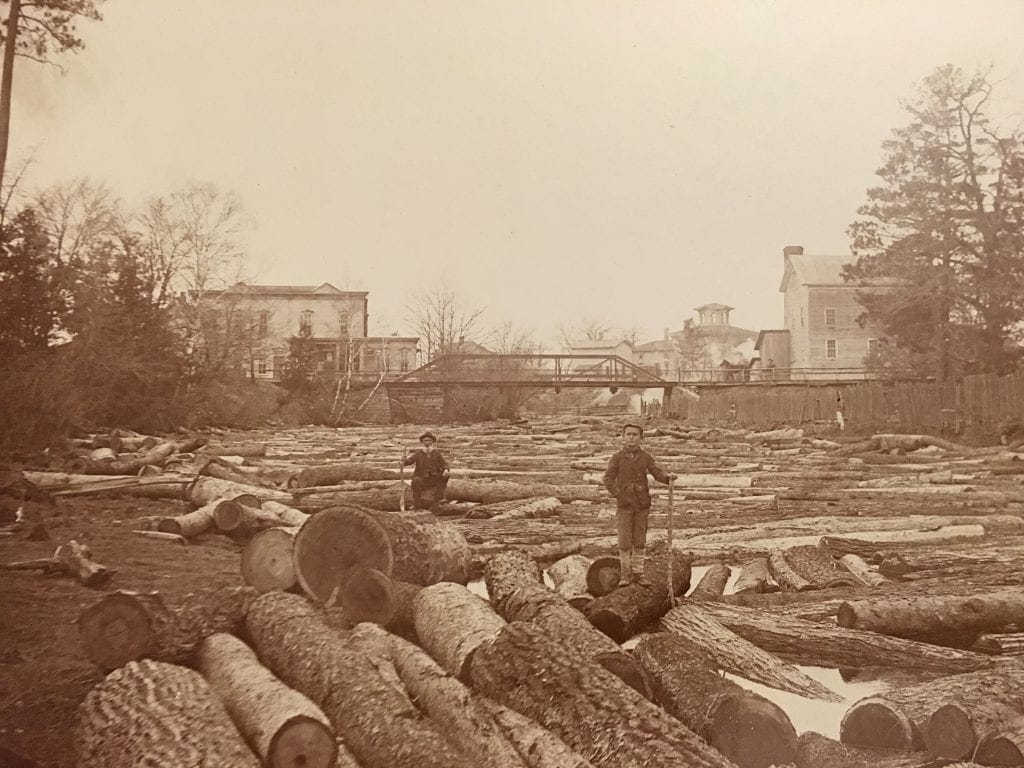
The fires of September 4th through the 6th 1881, commonly known as the Thumb Fire, took hundreds of lives and burned well over one million acres. The fire destroyed major parts of Tuscola, Huron, Sanilac, and St. Clair counties. It forever altered the landscape of the Upper Thumb and its effect is seen in the area today.
The Army was summoned to the area and asked to assess the disaster and seek its cause. The report was issued in the Spring of 1882.
“The summer of 1881 was excessively dry, and the drought had done its work nowhere more effectively than in the wide, blunt, tongue of land which lies between Saginaw bay and Lake Huron. At the northern end of this tongue is Huron County. South of Huron is the counties of Tuscola and Sanilac, the latter bordering on the lake. Lapeer County lies south partly of Tuscola and partly of Sanilac. These are the counties that suffered from the great fires.”
SIGNAL SERVICE NOTES, No. I. REPORT THE MICHIGAN FOREST FIRES OF 1881.
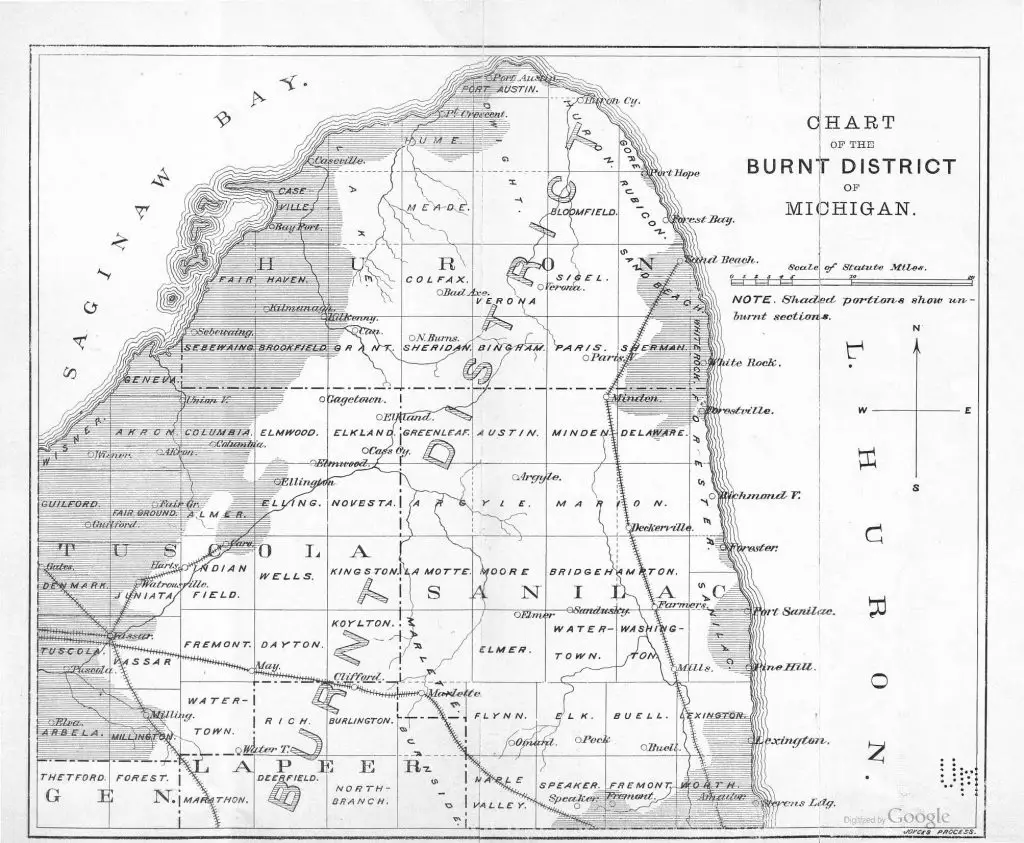
“In September no penetrating rain had fallen for almost two months. Almost every stream was dry. Many wells had become empty. The swamps had been burned to hard clay by the sun, fiercer in its heat than it had been for years before. The vegetation of the fields and woods had become tinder. The earth was baked and cracked, the heat having penetrated to an unusual depth.
Ten years before, a great fire had burned over the country, and had left standing acres of dead timber, and the sapless trunks and dry branches made splendid food for the flames. Some of the old trees had blown down, and the forests were full of ” wind-falls ” and of great piles of dead timber which are called ” slashings ” by the people of the settlements. Everything was ready to feed the fires when they finally came. Old roots, pine tops, branches, brush heaps, timber, and the parched earth made the fuel for the burning.”
SIGNAL SERVICE NOTES, No. I. REPORT THE MICHIGAN FOREST FIRES OF 1881.
Forestville Spared
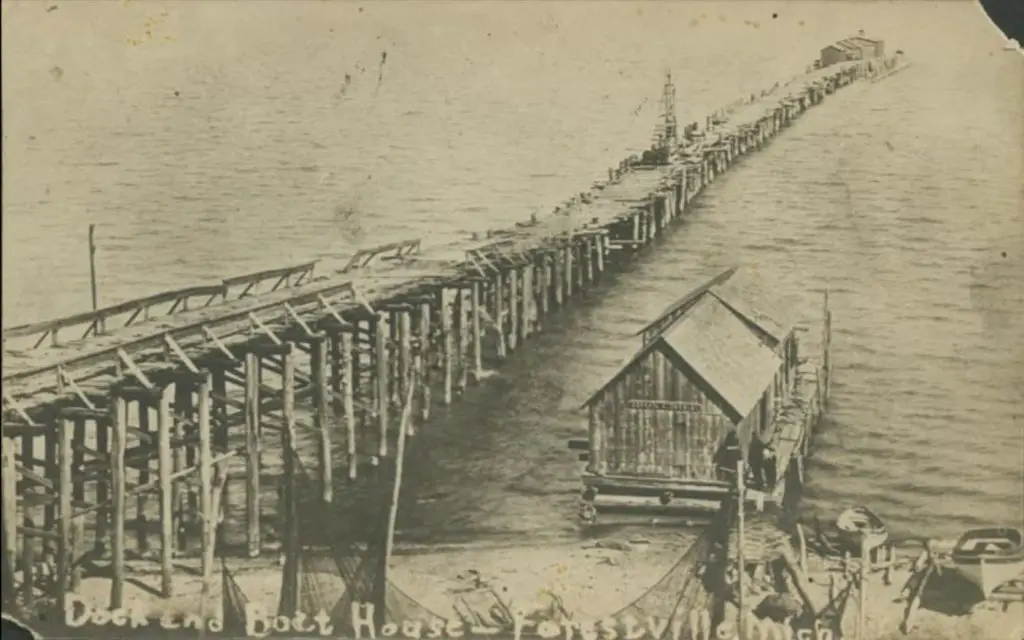
Along the eastern edge of the central Thumb, there was an enclave from Harbor Beach to White Rock which was spared the devastation of the fire. Forestville was spared through the quick action of volunteer firemen and a sudden shift of the wind.
One description of a family’s attempt to save themselves from the fire illustrates its intensity. Four miles west of Forestville, the Richmond family resided. They had a nine-foot-deep well located about fifty yards from their home. As the fire approached, the husband, Sylvester Richmond age 43 placed his wife Laura and six of their seven children in the well in two feet of standing water. He continued to fight the fire in an attempt to save his home until the fire’s heat was unbearable. He then joined his family in the well. The horrific firestorm lifted off the roof of the house and sent the burning debris over the well. The family was found two days later. All had suffocated while taking refuge in the well. The family’s only survivor, 13-year-old Kenneth Richmond, was not home the day of the fire.
In the end, the 1881 fire swept through the same path as the 1871 fire in Sanilac County. It killed over 275 people, consumed 3,000 buildings and numerous cattle, hogs, and other livestock.
News Coverage of Michigan’s 1881 Thumb Fire Was Nationwide
The area news covered the event with more interest. Newspapers of the day files reports like the following:
“The fire appeared at Bad Axe, 20 miles northeast of Cass City, a little after 1:30 p.m. Monday September 4th. The winds had begun at noon and, according to observers, trees were broken off at the stump, boulders rolled along like pebbles, and people lifted off their feet into the air. Above the wind, a strange roar was heard, the sound of the approaching flames. Shortly after 1 pm there was darkness, as though a curtain had fallen.
“Four hundred people fled to the new brick courthouse. As they watched, building after building burned around them. Thirty men pumped water from the adjoining well and kept the walls and tile roof wet. After a few minutes they had to return inside because of the heat, and another 30 would take over. Across the street, barrels of kerosene and gunpowder ignited when the hardware store burned. The store turned dark, and then blew into a bright, red glare.”
When the fire finally burned itself out, there were 282 known dead, more than 3,400 buildings destroyed, and almost 15,000 residents homeless. Many were blinded – some temporarily and some permanently – by smoke, gusting dust, and flying ashes that traveled faster than a whirlwind and blotted out the sun for days. The disaster changes the landscape of Michigan’s Thumb region forever and jump-started the move from lumbering to agriculture.
The 1881 Michigan Fire Blackened the Skies of New England

“In Boston and along the eastern seaboard a mysterious “yellow sky” appeared. The skies darkened shortly after dawn on Tuesday, September 6, 1881 – throughout all six New England states. In the “forenoon,” as they called their mornings then, witnesses watched a “London fog” envelop their homes and roads. This London fog soon took on a yellowish hue. More than a few whispered that the “Saffron Curtain” was the sign of a divine judgement. The causes behind the odd skies of that September day were eventually traced to smoke that had traveled eastward from Michigan’s massive “Thumb Fire” that had burnt over a million acres of woodlands in Michigan’s Thumb Area all on one day, the day before.”
The 1881 Michigan Fire Was the First Disaster Attended by the American Red Cross

In 1881 Clara Barton founded the American Red Cross. The organization’s first meeting had taken place in Washington DC at the home of Sen. Omar D. Conger of Michigan. Their first official disaster relief operation was the response to the Thumb Fire, and the Red Cross provided money, clothes, and household items to victims of the fire.
American Red Cross chapters collected supplies, food, and donations which were coordinated and shipped to Michigan to give aid to 14,000 people in need of help.
Chilling Eyewitness Accounts of the 1881 Michigan Fire
“Frances Cuza, a pretty-faced Polish girl, with ladylike manners and good English speakers, wearing a Derby hat with some tips of peacock feathers in it, evidently relief” goods, told the Inquirer about the scene at the bridge and the death of her mother (the mother also of Mrs. Kubccki). She said her father was just beside her, and her mother died of suffocation in his arms.
The girl’s lip quivered, her voice faltered, and her eyes tided with tears as she said: “We did not know my mother was dying till it was all over.” She said the fire was preceded by a wind-storm, and that lights, blue, red and green, were seen in all directions, and the atmosphere about them smelled of sulfur; that stones an inch in diameter tad red-hot fell among them, on their clothes, and burned them, showing as proof a well-shaped arm frightfully scarred from the wrist to the elbow.”
Michigan Fire Makes National News
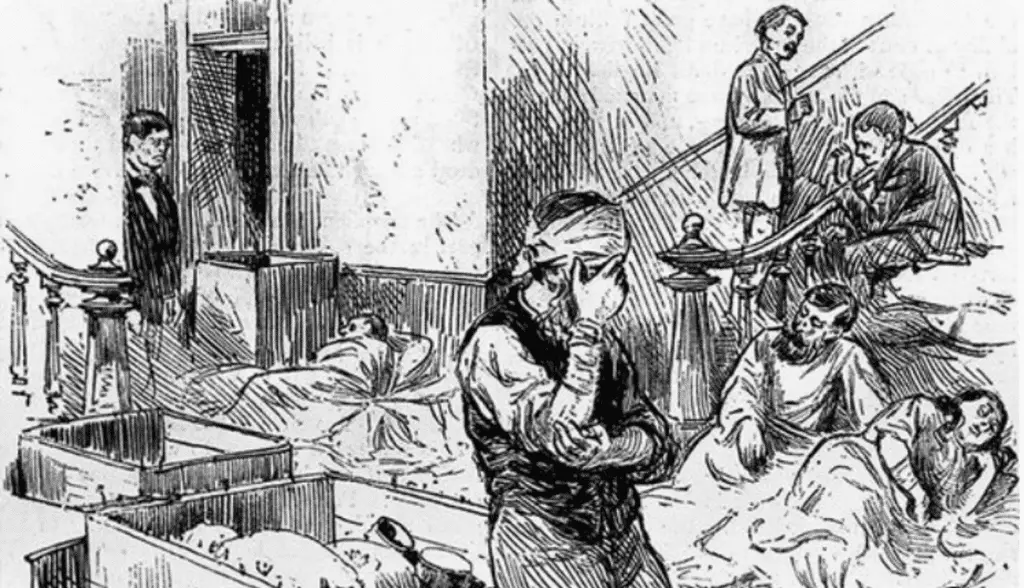
In the days and weeks after the fire, the news stories began to trickle to the world. By September 7th the New York Times printed a story in part.
“The village of Deckerville, on the Port Huron and North-western Railway, is totally consumed. Anderson Station is partly burned. In Mendon the only loss was the elevator. Port Hope is nearly all burned. In Verona Mills, in Huron County, the buildings are all destroyed but the church and a store. Bad Axe is all gone but the Court-house and a hotel. Sandusky is totally destroyed, and Richmondville is totally consumed. The fire is raging in the western part of Fortsville, and the people are all moving to the lake shore in Watertown Township two entire families have been burned to death. The mail-carrier from Marlette to Bad Axe is reported lost. The mail-carrier from Sandusky to Carsonville saw two dead bodies on his route, and the horrible truth remains only partially told.“
The New York Times, New York, New York, September 8th 1881
Michigan Historical Marker of 1881 Great Fire
This historical marker was placed in 1957 and located within the Brown Roadside Park, on the east side of M-25 about 1/2 mile south of the Pigeon Road (M-142)
“Great Fire of 1881 – Small fires were burning in the forests of the Thumb, tinder-dry after a long, hot summer, when a gale swept in from the southwest on Sept. 5, 1881. Fanned into an inferno, the fires raged for three days. A million acres were devastated in Sanilac and Huron counties alone. At least 125 persons died, and thousands more were left destitute. The new American Red Cross won support for its prompt aid to the fire victims. This was the first disaster relief furnished by this great organization.”
Did the Thumb Fire Affect Michigan Lakes, Rivers, and Fish Habitats?
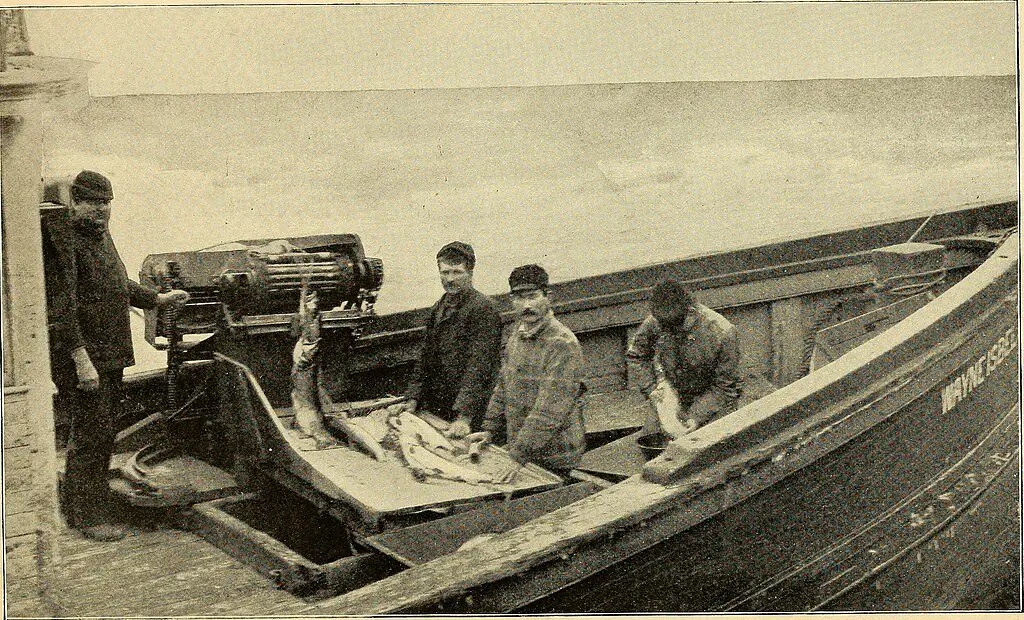
Like other large wildfires, the Thumb Fire likely had significant effects on local lakes, rivers, and fish habitats. Although specific historical records detailing the impact of the Thumb Fire on aquatic ecosystems might be limited due to the time period, we can infer potential effects based on the known impacts of large wildfires on aquatic systems. The fire would have generated large amounts of ash and debris, which could be washed into nearby lakes and rivers by rainfall after the fire. This could have led to changes in water chemistry, increased turbidity, and potential toxicity for aquatic life.
Sonar technology can conduct underwater surveys to identify structural damage after a great fire. For example, after the 2018 Camp Fire in California, the United States Geological Survey (USGS) and other agencies conducted sonar surveys in reservoirs and water bodies downstream of the burned area. The goal was to assess sediment and debris flow into the water bodies, which is a common issue after fires due to the loss of vegetation and altered soil properties.
Sonar works by emitting sound pulses into the water. If an object is in the path of the sound pulse, the sound bounces off the object and returns an echo to the sonar transducer. The transducer is mounted on the boat to measure the strength of the sonar signal. Sonar can effectively detect physical changes in aquatic environments that might result from a fire. For example, increased sedimentation, changes in the depth or shape of a water body, or the presence of large debris from burned vegetation or structures can be mapped using sonar.
How many people died in the 1881 Michigan Fire?
The stated death toll for the 1881 fire is stated as 282. However, the real total will never be known as there were many lumbermen and transient laborers in the region.
How many acres were destroyed in the 1881 Michigan Fire?
Over two days over a million acres were burned. It left 3,400 buildings destroyed, and almost 15,000 residents homeless.
What was the economic loss of the 1881 Michigan Fire?
The U.S. Army offered an estimate of $2,003,390. In today’s dollars that equates to over $50,000,000.
How Does the 1881 Michigan Fire Compare to Other Wildfires in History?
In terms of loss of life, the 1881 Great Michigan Fire is considered one of the top ten wildfires of all time. With 282 lives lost the 1881 wildfire is considered the 6th worst in history.
Sources Consulted
- Various public and private web pages
- New England’s Yellow Day of 1881: A Saffron Curtain Descends
- The True Northerner, 16 June 1882, Fri, Page 3
- The American Red Cross
- Signal Service Notes, No.1., Report, The Michigan Forest Fires of 1881., Published by Authority of the Secretary of War., Washington D.C. Office of the Cheif Signal Officer 1882
MLA Citation For this Story
Publications, T. (2022, May 12). 1881 Michigan Fire Forever Changed The Thumb. Thumbwind Publications. https://thumbwind.com/2021/09/04/1881-michigan-fire/
Related Michigan Thumb Stories Like the 1881 Fire
- The Destruction and Miracle of Parisville – The 1881 fire that swept much of Michigan’s Thumb devastated one town. However, stories of miraculous events are passed down today.
- 1871 Fire – The Great Lakes Burned – In Michigan’s Thumb, the situation could not be worse. The prevailing winds brought embers and dense smoke from the other Michigan fires burning in the west. Within hours over 2,000 lives were lost and millions of acres burned.
- Local Accounts Of The Great Michigan Fire Of 1881 – Shocking firsthand accounts of the Great Michigan Fire of 1881 from residents of Minden and Ubly. They were first published by the Minden Post soon after the fire and reprinted by many newspapers nationally. These accounts have never been published online before. Courtesy of the Minden City Herald
- Emil Baur Gave Relief To The Indians At Ora Labora After 1871 Great Fire – In October of 1871, a great forest fire swept across much of the Thumb region, including the section of Michigan that included the lands of the former colony of Ora Labora. The colony was in the process of being disbanded, and the lands were sold off, but large holdings remained, including some cabins and buildings. The colony’s benefactor and primary landowner, the Harmony Society, immediately sent $200 for distribution among the needy.

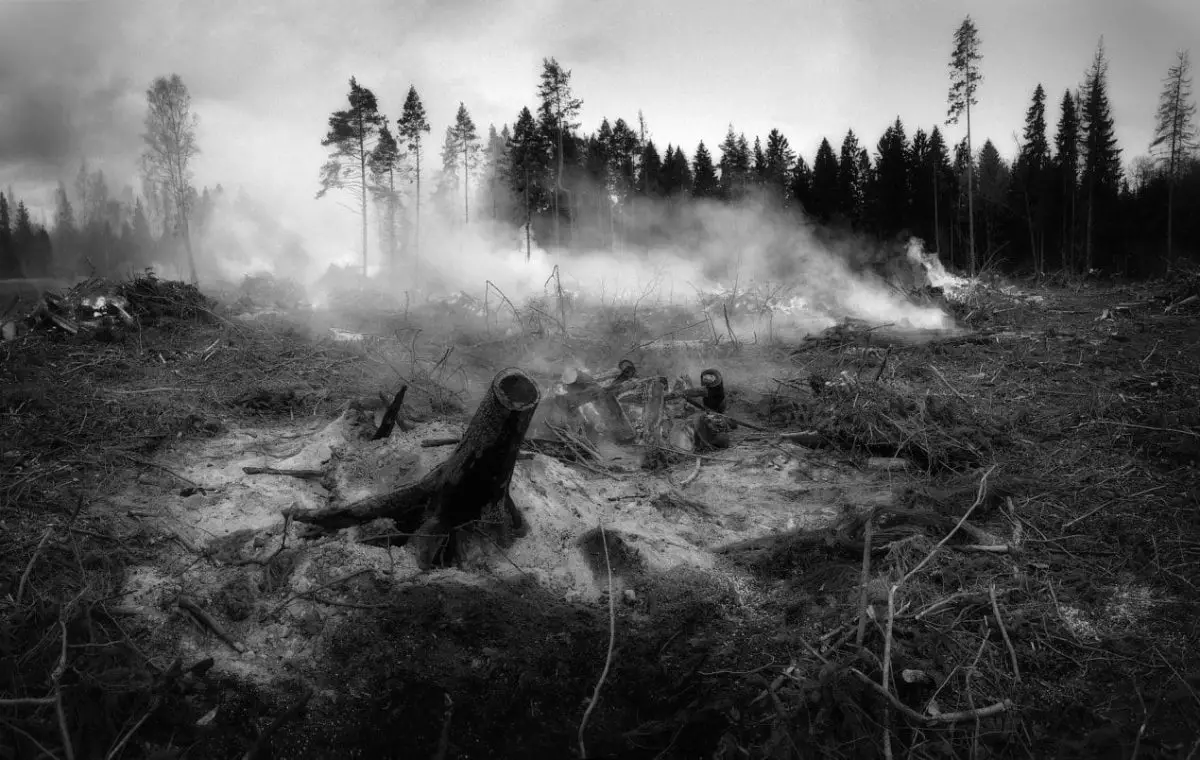
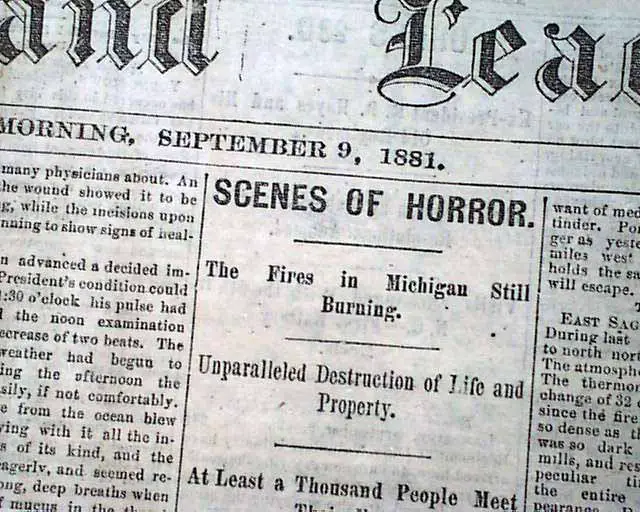


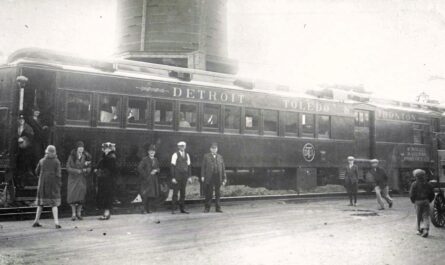
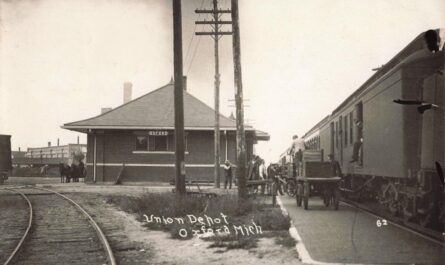
But it was human caused. Thanks for stopping by.
The woods I lived in most of my life was untouched. The fire stopped just a 1/4 mile south near M-25 between M-142 & Weale Rd, Bay Port.
The tree in my moms yard in brown city is the only survive from that fire.
That is indeed rare considering the inferno that took place.
Amazing…how old do you think they are.
Human caused? I didn’t read that in the article. Did I miss it?
Here is another version from another source to make it clear.The Great Forest Fire of 1881 was largely confined to the Thumb area. Logging in this area reached its peak in 1872. By 1881 the splendid stands of pine and hardwoods had been cut down, however, the loggers left a wilderness of slashings, consisting of pine tops, branches, stumps, and trees rejected by loggers after they had been cut down. In many places the slashings were 12 to 15 feet high and covered large areas of land. The Fire of 1871 had also left large masses of dead and fallen timber. Finally, after most of the tall pines had been cut, the underbrush had become thicker and thicker.
The summer of 1881 was excessively hot and dry. By September most of the streams had dried up. Even the swamps had been burned to a hard clay by the sun.
You may be interested in reading our Great Lakes Great Fires Meteor site concerning the 1871 fires in the Thumb. We found the meteorite on the shores of Lake Huron near the family cottage north of Port Sanilac – http://www.phoenixnavigation.com/meteorite/greatfires.htm
My grandfather who was born May 24, 1881 couldn’t remember the fire of course, but his parents had stories. Some people went down in their well to escape the flames but suffocated instead.Others fled to Lake Huron. My grandfather, on my fathers side, with his father and brother made a living for a number of years selling fire wood. They also used logs for the base for some of the roads. Part of the payment for the work on the roads was to be given 12 lots in Downing Cemetery. This all took place in the Deckerville area.
My Grandmother and Clara Barton were related and I grew up in the thumb, Sanilac county. So I tend to have an interest in this story.
Amazing…do you know if Clara Barton visited your Grandmother?
This is a great article it is also a piece of history that I had not head before so I am going to reblog this article for you.
lost family members in fire according to our story handed down through the ages…
Jeez…I never said thank you
Sometimes it’s a little win that makes your day. NPR cited this story with their coverage of the horrific situation with Maui’s wildfires. https://www.npr.org/2023/08/15/1193710165/maui-wildfires-deadliest-us-history
My maternal grandmother was a young girl living in Brown City at the time of the 1881 Thumb Fire. She told me that the smoke was so thick that she and her brother crawled home from school on their hands and knees. The smoke was not quite as thick near the ground. Her family and their home survived the fire. Her recollections of the fire were published in the Brown City Banner several years ago but I have never found the article.
Wow! Do you happen to know the approximate date it was in the paper?
I’m not sure of the date, but I would guess the Brown City Banner interviewed her for the article in late 1960s or early 1970s. She passed at almost 100 years old in 1978.